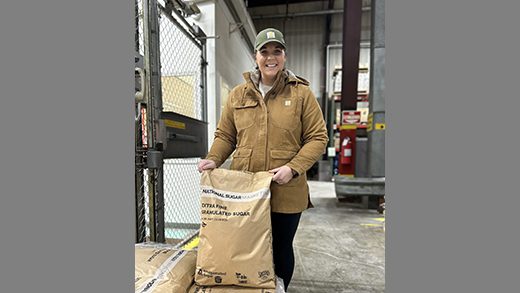Did you know that U.S. Department of Agriculture (USDA) has been reporting food supply data for over 100 years?! And for over 30 years, USDA has been monitoring actual intakes of Americans. This extensive history provides us important insights into dietary intake trends and changes in the food supply.
One important report that USDA publishes is its dietary status report, “What We Eat in America (WWEIA).” The WWEIA report comes out every two years with data from the National Health and Nutrition Examination Survey (NHANES), assessing the health status and dietary intakes of Americans. This report includes data on added sugars intake, and the findings from the last 20 years may surprise you. The most recent report shows that the percent of total calories from added sugars fell from 18.1% in 2000 to 12.6% in 2016.1,2,3 For reference, the 2015-2020 Dietary Guidelines for Americans recommend that added sugars be limited to 10% of total calories.4
While the total added sugars intake data is always interesting, there were more questions we had, like where do people get their added sugars? And, do people who eat very little added sugars avoid all treats? Do people who eat lots of added sugars get their added sugars from a different place? Because we at the Sugar Association believe that increasing our knowledge about sugar is beneficial to understanding it’s role in the diet, we asked researchers to take a deeper dive into the NHANES data from 2009-2012 to look at patterns of the sources of added sugars in adults.5 The researchers split the participants into 10 equal groups (deciles) to see how these patterns differed across that range of intakes (low to high). The mean intake of added sugars was 13.1% of total calories, with the lowest consumers (decile 1) at <11.9%, the highest (decile 10) at >19.6% and the middle (decile 5) being around 15%. So, did the sources of added sugars differ across intakes? Let’s look a little closer at what the researchers found.
Sweetened beverages are the major contributor of added sugars for the highest consumers, making up about half (51%) of the total added sugars calories. For the middle consumers, sweetened beverages were still the number-one source, making up less than a quarter (23%) of added sugars calories. However, for the lowest consumers, sweetened beverages make up only 4% of their added sugars calories!5
When looking at these data, it is important to keep in mind that making it into the top sources is a combination of how many added sugars are in the product, along with how frequently the products are consumed.
Top 10 Food Sources of Added Sugars for Adults by Decile of Intake5
| Rank | Decile 1 | Decile 5 | Decile 10 | |||
| Food Category | % Total Added Sugars from Food Category | Food Category | % Total Added Sugars from Food Category | Food Category | % Total Added Sugars from Food Category | |
| 1 | Breads, Rolls, Tortillas | 20.0 | Sweetened Beverages | 23.1 | Sweetened Beverages | 51.4 |
| 2 | Sweet Bakery Products | 10.4 | Sweet Bakery Products | 13.9 | Coffee and Tea | 10.6 |
| 3 | Fats and Oils | 9.7 | Sugars | 9.5 | Sweet Bakery Products | 9.5 |
| 4 | Ready-to-Eat Cereals | 7.2 | Other Desserts | 6.8 | Sugars | 6.4 |
| 5 | Sugars | 5.8 | Candy | 6.6 | Candy | 4.8 |
| 6 | Candy | 5.5 | Coffee and Tea | 6.1 | Other Desserts | 4.5 |
| 7 | Sweetened Beverages | 4.4 | Bread, Rolls, Tortillas | 5.8 | Ready-to-Eat Cereals | 2.2 |
| 8 | Condiments and Sauces | 3.8 | Ready-to-Eat Cereals | 5.3 | Fats and Oils | 1.2 |
| 9 | Mixed Dishes-Sandwiches | 3.2 | Fats and Oils | 3.4 | Breads, Rolls, Tortillas | 1.1 |
| 10 | Cured Meats/Poultry | 2.8 | Snack/Meal Bars | 2.0 | Quick Breads and Bread Products | 1.1 |
As added sugars intake increases, sweetened beverages are major contributors.5
References:
- Welsh JA, Sharma AJ, Grellinger L, Vos MB. Consumption of added sugars is decreasing in the United States. Am J Clin Nutr. 2011;94(3):726–734.
- U.S. Department of Agriculture Agricultural Research Service, Beltsville Human Nutrition Research Center, Food Surveys Research Group. Food Patterns Equivalents Databases and Datasets. Available at: https://www.ars.usda.gov/Services/docs.htm?docid=23869. Updated September 20, 2018. Accessed October 10, 2018.
- U.S. Department of Agriculture Agricultural Research Service, Beltsville Human Nutrition Research Center, Food Surveys Research Group. WWEIA data tables. Available at: https://www.ars.usda.gov/northeast-area/beltsville-md-bhnrc/beltsville-human-nutrition-research-center/food-surveys-research-group/docs/wweia-data-tables/. Accessed October 10, 2018.
- U.S. Department of Health and Human Services, U.S. Department of Agriculture. 2015–2020 Dietary Guidelines for Americans. 8th ed. Available at: http://health.gov/dietaryguidelines/2015/guidelines/. Published December 2015. Accessed April 10, 2018.
- Bailey RL, Fulgoni VL, Cowan AE, Gaine PC. Sources of added sugars in young children, adolescents, and adults with low and high intakes of added sugars. Nutrients. 2018;10(1):E102.





Get Social with #MoreToSugar